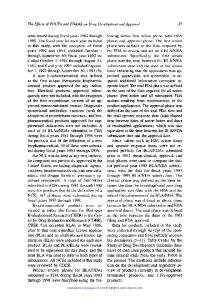The Role of the Food and Drug Administration in Pharmacoeconomic Evaluation During the Drug Development Process
- PDF / 510,021 Bytes
- 8 Pages / 504 x 719.759 pts Page_size
- 72 Downloads / 324 Views
0092-8615/2000 Copyright 0 2000 Drug Information Association Inc.
THE ROLE OF THE FOOD AND DRUG ADMINISTRATION IN PHARMACOECONOMIC EVALUATION DURING THE DRUG DEVELOPMENT PROCESS* JENNIFER KIM, PHARMD,CAROLYN BLANKMORRIS,MPH, AND KEVIN ALANSCHULMAN, MD Clinical Economics Research Unit, Georgetown University Medical Center, Washington, District of Columbia
Economic analysis is increasingly being integrated into Phase 111 clinical trials. In 1995, the Clinical Economics Research Unit of Georgetown University Medical Center implemented a survey to assess the use ofphannacoeconomic data in the clinical development process. This survey gathered information regarding the companies’ use of economic analyses in the drug approval process and the analyses commented upon by the Food and Drug Administration (FDA) in its review ( I 7). The results from the 1995 survey found that companies reported that phannacoeconomic data were increasingly being submitted to the FDA in product approval packages, and that the FDA increasingly commented on these data. Given the growth of interest in economic evaluation since 1995, the survey was re-implemented in 1998 to examine the current state of the art in economic evaluation. The results indicate continuing and expanding interest in submitting pharmacoeconomic data to the FDA during the drug development process and reports of recent approval of economic claims in product labeling. Key Words: Clinical economics; Cost-effectiveness analysis; Food and Drug Administration
ECONOMIC ANALYSIS IS increasingly being integrated into Phase I11 clinical trials (1-5). Broadly defined, economic analysis can include an evaluation of resource consumption by study patients, an analysis of quality of life of study patients, or an analysis
*An earlier version of this article was published in the
Drug Information Journal in 1995 (Volume 29, Issue 4, 1105-1 11 1). Reprint address: Kevin A. Schulman, MD, Center for Clinical and Genetic Economics, Duke Clinical Research Institute. Duke University Medical Center, PO Box 17969, Durham, NC 27715.
of the cost-effectiveness of new therapeutic products (2,6,7). These data can be used to demonstrate the safety or efficacy of drugs for product licensure or approval decisions, to support applications for reimbursement from national health authorities (8,9,10), or to support promotional activities of manufacturers (7). By statute, the FDA makes approval determinations on the basis of product safety and efficacy (11,12,13). Economic measures, such as resource utilization, may be used as study endpoints in establishing product efficacy. For example, hospitalization rates, a
1207
Downloaded from dij.sagepub.com at NANYANG TECH UNIV LIBRARY on April 26, 2015
Jennifer Kim, Carolyn Blank Morris, and Kevin Alan Schulman
1208
common economic measure, served as a secondary endpoint in the Cardiac Insufficiency Bisoprolol Study I1 (CIBIS 11) evaluating the effectiveness of bisoprolol in chronic heart failure patients (14). In the Evaluation of Losartan in the Elderly stu
Data Loading...











